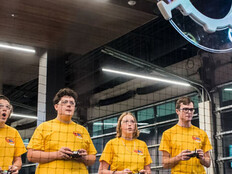Video Games Can Be Educational — Really!
What if you could harness students’ passion for video games, teach them valuable life and technical skills, and see them go on to pursue college or a career in the game design industry?
Four years ago, John B. Connally High School in Austin, Texas, introduced a STEAM — STEM plus the arts — video game program that engages students in interactive classroom activities and motivates them to achieve their long-term goals by applying classroom lessons to their real-world interests and passions. We have found that video game technology in particular increases student engagement in learning about real-world problems because video games are already so familiar to students and a source of entertainment for so many young people.
Participants in our Infinity Game Design program work individually and in groups to research, analyze and troubleshoot topics such as solar energy, healthy living, sustainability and green racing. Classroom activities include journaling, role-playing, interviewing, moviemaking, podcasting, solution mapping, photography, scrapbooking and animating.
To begin their video game project, students match their interests to potential careers by signing up to serve in one of four roles:
- 3 Project managers oversee the student teams as they work on different facets of their game.
- 3 Programmers are responsible for building the game using the Unity game engine.
- 3 Graphic designers create textures and paint the 3D model files that go into the game engine.
- 3 Sound designers identify and create the sounds that bring realism to the game.
The students then develop their mastery of the hardware and software applications that appeal to their personal interests and learning styles using lynda.com and other resources. They use Adobe Creative Suite, for example, and other digital media tools to design video games that synthesize their knowledge and teach players about their research topic in an engaging way. From these efforts, they develop college readiness skills in computer science and fine arts, project-based learning strategies and facility with the technologies that creative professionals use in their everyday work.
Professionals from the local game design industry are actively involved as well, delivering presentations about their companies and the work that they do, offering up challenges for students to “solve” within the games they create and evaluating that work upon completion.
Finding The Value of Video Games
Game-based learning is valuable for students because it evolves constantly — as do students themselves. Video games present new challenges and adjust to students’ changing abilities, creating personal relevance and a level of engagement that’s difficult to achieve through traditional instructional methods.
When this type of engagement occurs, learning becomes a process of discovery. And from that, students begin to identify where their personal interests lie — be they artistic, scientific or something else entirely — and which careers are best suited to those interests.









